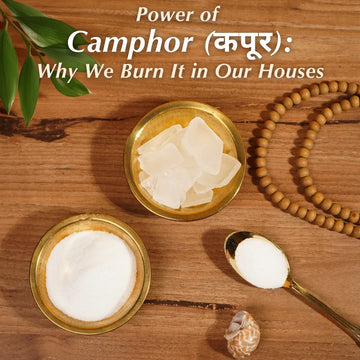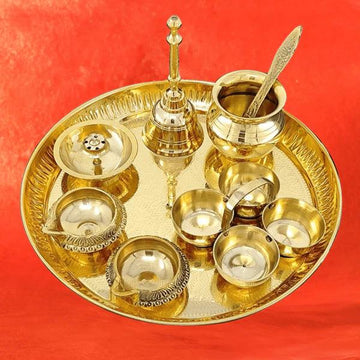Pooja, or Hindu worship, is a deeply symbolic ritual that involves various items, each carrying significant meaning and purpose. Understanding the role and symbolism of these pooja items enriches the spiritual experience, fostering a deeper connection with the divine. This blog explores the key pooja items commonly used in Hindu rituals and their symbolic significance.
- Pooja Thali
Role:
The pooja thali is a plate used to hold and present various offerings to the deity. It typically contains items like rice, flowers, incense, and a diya (lamp).
Symbolism:
The thali represents the entirety of the devotee's offerings and devotion. It symbolizes the act of offering oneself to the divine, encompassing purity, love, and respect.
- Diyas (Oil Lamps)
Role:
Diyas are small lamps usually made of clay, filled with oil or ghee, and lit during the pooja. They are placed on the altar or around the worship area.
Symbolism:
The flame of the diya signifies the removal of darkness and ignorance, bringing light and knowledge. It symbolizes the presence of divine light in the home and the dispelling of negative energies.
- Incense Sticks (Agarbatti)
Role:
Incense sticks are lit and placed in holders during pooja. The fragrant smoke is believed to purify the surroundings.
Symbolism:
The burning of incense represents the transformation of physical matter into spiritual essence. The rising smoke symbolizes prayers reaching the heavens, carrying the devotee's wishes and devotion to the deities.
- Kumkum and Haldi (Turmeric)
Role:
Kumkum (red powder) and haldi (yellow turmeric powder) are applied to the forehead and offered to the deity.
Symbolism:
Kumkum represents the life force and spiritual energy. It is often associated with the third eye and awakening of inner vision. Haldi symbolizes purity, fertility, and prosperity.
- Flowers
Role:
Fresh flowers are offered to the deities and used to decorate the altar.
Symbolism:
Flowers symbolize beauty, love, and devotion. They represent the impermanence of life and the act of offering one's best to the divine. Different flowers carry different significances; for example, lotuses symbolize purity and spiritual enlightenment.
- Pooja Bell (Ghanti)
Role:
The pooja bell is rung during the ritual to invite the deity and create a sanctified atmosphere.
Symbolism:
The sound of the bell represents the voice of the divine. It purifies the environment, wards off negative energies, and signifies the beginning and end of the pooja.
- Pooja Kalash
Role:
The kalash is a metal pot filled with water, adorned with mango leaves and a coconut on top. It is placed on the altar during pooja.
Symbolism:
The kalash symbolizes the universe and the source of life. The water inside represents the primordial water from which creation emerged. The coconut and mango leaves signify fertility, prosperity, and the sustenance of life.
- Rice (Akshata)
Role:
Rice grains are used in various rituals, including offering to the deity and applying tilak (a mark) on the forehead.
Symbolism:
Rice symbolizes abundance, prosperity, and purity. It is considered a sacred grain that sustains life, making it a fitting offering to the divine.
- Conch Shell (Shankh)
Role:
The conch shell is blown at the beginning of the pooja and during significant moments of the ritual.
Symbolism:
The sound of the conch represents the sacred syllable "Om," the primordial sound of creation. It symbolizes auspiciousness, purity, and the presence of divine energy.
- Holy Water (Ganga Jal)
Role:
Holy water, often from the Ganges River, is used to purify the pooja items and the worship space. It is also sprinkled on the devotees.
Symbolism:
Holy water signifies purity and spiritual cleansing. It is believed to have the power to purify the mind, body, and soul, preparing the devotee for communion with the divine.
Each pooja item used in Hindu rituals carries profound symbolism and plays a crucial role in the worship process. By understanding the significance of these items, devotees can deepen their spiritual practice and enhance their connection with the divine. The thoughtful use of these symbols fosters a richer, more meaningful pooja experience, reflecting the timeless traditions and spiritual heritage of Hinduism.













